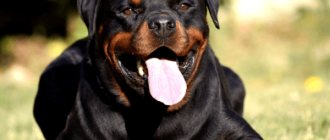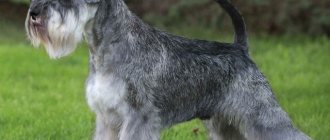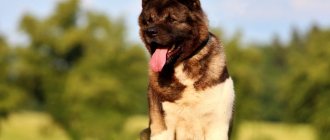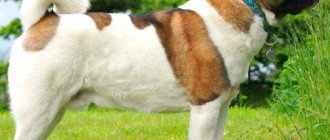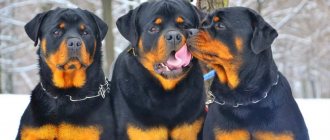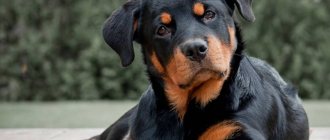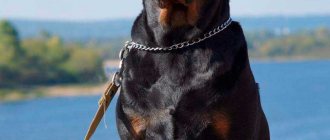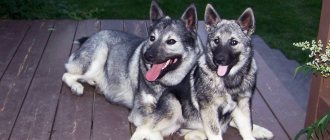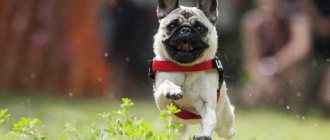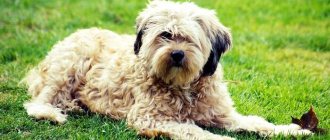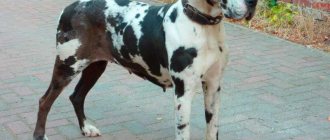It is believed that the Rottweiler is a very dangerous dog, capable of suddenly biting and even mauling a person. The opinion is fueled by numerous press reports about attacks by these animals on people. However, this is not a fighting dog. The standard clearly states the following characteristics: the breed is a service and working breed.
The dog is unusually loyal, friendly and calm. Let's figure out what turns pets into vicious killers.
A Brief History of the Rottweiler Breed
The breed is descended from mastiff-like dogs that lived in ancient Rome - this is the most popular version, but the exact history remains a mystery. Most likely, the ancestors were Tibetan mastiffs. In those days, animals were used for driving and grazing livestock.
Later they ended up in the German region of Rottweil, where they were involved in guarding and transporting convoys with meat.
At the beginning of the 20th century, the need arose to use dogs for police purposes. They passed tests that confirmed their fitness for duty. In 1921, the first breed club was created, whose members developed an official standard.
Tail docking
The need to dock the tails of Rottweilers was due to the lifestyle of the dogs and their purpose - participation in battles, driving and guarding livestock. In these situations, the tail was a hindrance and increased the dog's vulnerability.
Modern Rottweilers do not experience any inconvenience with their natural tail length, so if they have their tail docked, it is only if they have injuries that are incompatible with life.
In 1998, tail docking was stopped and this procedure was recognized as inhumane treatment of the animal.
Interesting Facts
There are many interesting things associated with the Rottweiler breed. Here are just some facts:
- According to historical data, dogs resembling modern representatives of the breed took part in the Seven Years' War - one of the largest armed conflicts of the 18th century.
- In the old days, German butchers hung purses around the necks of their dogs. No one in their right mind would risk robbing a four-legged defender.
- Rottweilers are prohibited from being imported into some countries because they are considered potentially dangerous. The list includes Israel, Bermuda, Portugal, Ecuador.
Purpose
According to the breed classification, Rottweilers belong to service or guard animals, but this does not characterize even a fraction of their possible potential.
In addition to the historical function of escorting goods and protecting them, Rottweilers have adapted to help in various law enforcement agencies and search services. The breed is widely used by police officers along with German Shepherds.
Thanks to their fearlessness, dogs of this breed provide irreplaceable assistance during search and rescue operations year after year. Dogs are able to get into places inaccessible to people and find them under rubble.
At home, the dog gets along well and will never purposefully try to harm its owners or their children. However, due to the clumsiness and sluggishness of the Rottweiler, there is a high probability of accidentally knocking over or hitting the baby, as a result of which he may fall or hit himself.
The dog protects the territory entrusted by the owner from strangers. This dog provides excellent assistance in agriculture, in particular when driving livestock to pastures. In hunting, the breed is valued for its ability to pursue and drive game for a long time.
Breed description, standards and appearance
The Rottweiler is a large dog, strong, but not very massive. Correctly built individuals demonstrate strength and power, concentrated in a fairly compact body.
Dimensions of an adult dog of this breed:
- boys' height is 61-68 cm, girls' height is 56-63 cm;
- the maximum weight of a Rottweiler is 50 kg and 42 kg, respectively.
This is interesting. The largest Rottweiler in the world weighs more than 95 kg. A girl named Bewdel lives in the UK. She became the star of the show Fat Pets.
Also, when assessing the exterior, other dimensions of an adult animal are taken into account - the elongation index, the depth and width of the chest, the width of the ribs.
Official description of the Rottweiler breed (ICF standard No. 147):
- The skull is wide, with a prominent forehead line.
- The length of the muzzle is proportional to the skull.
- The nose is wide and black.
- The lips fit tightly to the jaws.
- The jaws are powerful and strong, closed in a scissor bite.
- The eyes are dark brown, medium, almond-shaped.
- The ears of the representatives of the breed are hanging, triangular in shape, sitting high and wide.
- The neck is strong, with a slightly curved nape line.
- The chest is massive and deep. The back and loin are powerful and strong, the croup is wide and slightly rounded. The belly is not tucked in.
- The modern characteristics of the breed allow the tail to be left in its natural form. Previously it was subject to docking.
- The limbs are straight, set quite widely.
Color
Representatives of the breed have a two-layer coat with a thick undercoat. The only permitted color for a Rottweiler is black and tan. Red-brown markings are located in strictly defined places - on the face, throat, chest and paws, around the genitals.
Experts are lenient when it comes to excessively extensive markings - this is a defect, but not a disqualifying defect. But a completely black Rottweiler means that there are deviations in the genotype - blackened tan. Such a dog cannot participate in exhibitions, just like a chocolate Rottweiler.
Other deviations from the standard are the red and golden Rottweiler. These are not varieties, but mestizos with related breeds. In particular, with Dogues de Bordeaux and boxers.
On a note. Some people mistakenly believe that there is a Golden Rottweiler or Golden Rottweiler. The confusion is caused by its similarity with another breed - the golden retriever (golden retriever). These are completely different animals.
The white Rottweiler does not exist in nature. If there are white spots on the body, the animal is disqualified. Sometimes lightening of the color provokes a disease - vitiligo.
The puppy may also be born with long hair. Representatives of the breed with long or curly hair are immediately discarded.
Are there white individuals?
Since the history of this breed begins with the Romans, and then Germany in the 18th century, sometimes there are breeds with white spots. But they are not completely white.
- There is a disease called “vitiligo”, when a dog turns from a dark color to white. This is the process of depigmentation of the skin. This phenomenon has not yet been fully studied. Naturally, an animal with such defects is excluded from breeding and disqualified.
- There is another situation when the dog has black stripes on its tan marks, similar to tiger coloring. This phenomenon is transmitted at the genetic level from ancestors, but is also considered a defect.
- The next drawback is when the tan marks are blurred and there is no clarity. The wool takes on a black-and-white color. The alternation of black and brown hairs gives a peculiar pattern. Therefore, such hazel grouse puppies are withdrawn from further breeding.
Breed varieties
There are no recognized intrabreed varieties, but the standards of different countries have some differences:
- German are classic representatives of the breed. It was their characteristics that formed the basis of the ICF standard.
- English - English breeders focused on the character of the dogs: they achieved complete equanimity while maintaining working qualities.
- American - larger and more aggressive individuals were used for breeding. Animals are ready to tear apart any creature that invades their territory.
Breed characteristics vary slightly depending on the breeding line. Finnish dogs have elongated muzzles, a stocky build and a lightened color, Austrian dogs are slightly shorter than standard dogs, but perfectly built, Norwegian dogs are taller due to their long limbs.
Depending on height, the FCI standard divides the breed into 4 groups:
| Height (cm) | Characteristic | |
| Boy | Girl | |
| 61-62 | 56-57 | Little rottweiler |
| 63-64 | 58-59 | Average |
| 65-66 | 60-61 | Normal (preferred) |
| 67-68 | 62-63 | Large |
Due to breeder errors, birth injuries or genetic abnormalities, a mini species appeared. Such dogs are smaller than even the smallest standards. Usually they have a whole bunch of concomitant diseases, so the dwarf Rottweiler is not allowed to participate in exhibitions and breeding.
Evil or good?
The work for which Rottweilers were bred was associated with extreme factors that formed courage, endurance, strength and aggression in these dogs.
Modern Rottweilers are not without these qualities, despite the fact that all breeding work is aimed at producing dogs with a stable psyche and lack of aggression.
The Rottweiler itself is not evil, but at the same time it has a highly developed guard instinct, which causes its aggressive behavior if something seems suspicious to the dog. Only properly raised representatives of the breed who have undergone high-quality training do not have natural cruelty.
IMPORTANT!
It is very important to accustom your Rottweiler to calm behavior in extreme conditions and complete obedience to the owner.
Character and behavior
Despite its menacing appearance, the Rottweiler's character is characterized by friendliness, loyalty and obedience. At the same time, dogs of this breed are self-confident, fearless and balanced. However, kindness extends only to the owner and his family members - the animal perceives strangers as a potential threat.
On a note. Features of the Rottweiler breed are sensitivity to the environment and the mood of the owner. In families where there is often scandal, dogs grow up nervous and angry.
Rottweiler and children
A well-mannered dog and a child will become good friends. The pet will tolerate small pranks, but it is forbidden to show obvious disrespect - pulling ears and tail, poking in the eyes. The dog may bite the baby in an attempt to show that such behavior is unacceptable. Therefore, it is dangerous to leave a dog unattended in a children's room.
Watchdog and security qualities
This breed of dog has excellent working characteristics - the animals make decisions with lightning speed if the owner or his property is in danger. But to develop the innate potential, regular classes and professional training are necessary.
Owner reviews
My husband really wanted a Rottweiler. I was just raving about it. I couldn’t resist him and one day I became the owner of a two-month-old puppy, who was named Ray. Ray was a very smart guy. Within about a month, he learned to do all his dirty deeds on the street. I missed one very important point - education. As a result, he did not perceive me as an owner in any way. He did what he wanted. He even showed more respect to the cat. But he definitely took my husband for the leader. He never coddled him and always spoke in a commanding voice. Ray is no longer with us. Despite my great love for him, I will never own a Rottweiler again, as this breed does not suit my personality. Well, I can handle it.
Valeria, Ryazan.
Dogs have always lived in my house. Bolonka, Chihuahua. But I always dreamed of a big dog. One day I came to the kennel and couldn’t leave without a puppy. I understood that I was not doing a completely deliberate act, but I never regretted it. I loved my Rudolph with all my heart. We walked together and went jogging in the morning. He really liked to rub his fur against the same place on the wall, and soon there was a black spot there. This breed is not picky when it comes to food and care. But you need to monitor your weight, as Rottweilers are prone to obesity. At that time, I was already living separately from my parents, but my dad began to visit more and more often. And he clearly didn’t come to me. He has become attached to Rudolph with all his heart and will persuade me to give him to mom and dad. They spoiled the dog, feeding him sausage and dumplings. Because of this, Rudik began to gain weight and eventually died due to heart failure. My dad had to experience the fact that this breed is an excellent guard. One late evening, when he was walking with Rudolf in the park, a man approached him with a knife in his hands. Our dog, who was running in the bushes at that moment, immediately rushed at him. Dad barely managed to tear off the robber's dog, but Rudolf received 4 deep stab wounds. We barely managed to save him then. Insanely strong, loyal and the best breed.
Olga, Chisinau.
How to choose the right Rottweiler puppy?
A Rottweiler puppy is ready to go to a new home at 8-10 weeks. Babies should be purchased from reliable nurseries registered with the RKF/IKF. Sick animals or puppies with temperament defects are often sold on the Internet.
A responsible breeder will provide detailed characteristics of the litter and parents. An adult Rottweiler should be calm, balanced and friendly.
Important. To make sure that your Rottweiler puppy does not suffer from dysplasia, you need to study x-rays of the parents' limbs.
The breeder's willingness to answer all questions speaks in favor of the breeder. He will definitely ask where the Rottweiler puppy will live and whether the future owner has experience in raising large dogs.
Equally important are the conditions of detention - the Rottweiler puppy should be in a spacious, clean and dry enclosure. healthy babies play with pleasure with their relatives, are not afraid and do not hide from strangers.
You should pay attention to the character - even if the Rottweiler puppy becomes a bodyguard or security guard, he should not be overly angry. Such dogs are culled.
When the choice of a puppy is made, the parties sign a purchase and sale agreement, guaranteeing the breed and health of the dog. Along with the document, the breeder gives the owner a veterinary passport and birth certificate.
The cost of puppies varies depending on the class: pet-class dogs can be bought for 12,000-18,000 rubles, breed class for 18,000-50,000 rubles, and show class, as always the most expensive, – 60,000-100 000 rub.
On a note. Pedigree puppies can be bought in Moscow at the Olburd kennels https://www.olburd.ru and the Tsarskaya Stay kennels https://www.rottweiler-rkf.com.
Boy or girl?
The characteristics of representatives of both sexes have their own characteristics. Male dogs look solid and impressive, but only a physically and mentally strong man can cope with him. A Rottweiler girl is suitable for a person with little experience - she is softer and calmer. However, females do not tolerate members of the canine community of the same sex.
Mating
Rottweiler mating, unfortunately, is not always purebred. If the owner needs a status for puppies and a pedigree, then it is better to contact a nursery, which can issue a special certificate and form for mating. You need to select a male dog in advance in order to agree on a date. The cost of mating is determined by the boy's owner. As a rule, it is equal to one puppy or a percentage of its value. If the female does not become pregnant, no amount is paid.
To determine the date, you need to study the female’s cycles. Mating can be carried out only on the third heat (14-15 days from the beginning). During this period, the loop should soften, the discharge becomes lightish, and the behavior changes to playful. Although puberty comes earlier (about 8-10 months), it is recommended to untie dogs only by the age of 2 years.
In order for everything to go well, the female is brought to the territory of the male. You can walk the animals in advance and give them time to get to know each other. There should be a lot of free space in the house. If the female is ready, the cable will be able to mount. For the first time, dogs need help: holding, guiding. You can invite an experienced specialist. The act lasts no longer than 15 minutes. There may not be a castle. This does not mean that the girl is empty. Bonding can be done after 48 hours.
Care and maintenance
Caring for a Rottweiler is not at all difficult - the characteristics of the breed include unpretentiousness. It is enough to carry out hygiene procedures on time and walk your pet regularly.
The idea of keeping a Rottweiler outside in winter in a private home seems absurd to some people. At first glance, it seems that short wool does not retain heat well. However, many owners and breeders advocate keeping them outside.
Representatives of the breed do not tolerate heat very well, but the Rottweiler can live outside in winter if there is an insulated kennel. With the onset of cold weather, the dog acquires a thick undercoat, which perfectly protects against frost.
Street keeping is suitable for residents of the middle zone - in this region animals easily endure winter. But at extremely low temperatures, the booth or enclosure must be heated.
Important. In winter, the Rottweiler needs more food because it uses a lot of energy.
Caring for your Rottweiler includes regular walks. According to the law of the Russian Federation, a dog must always be on a leash and muzzle on the street. All potentially dangerous breeds need appropriate ammunition.
It is better to purchase a muzzle for a Rottweiler from metal wire with a chrome coating and a leather insert in the bridge of the nose. This design is quite strong, durable and comfortable.
The right diet
Representatives of the breed can eat both high-quality ready-made food and homemade food. With natural feeding, the basis of nutrition for an adult dog is lean meat and offal. Additionally, pets are given:
- sea fish;
- porridges – rice, oatmeal, buckwheat;
- fermented milk products;
- eggs;
- fresh or boiled vegetables.
A Rottweiler living in an apartment needs vitamins more than a street dog, since it does not receive enough fresh air and sunlight. Suitable supplements should be selected in consultation with your veterinarian.
For information on how to balance your dog’s diet, read the article “What to feed your Rottweiler.”
Walking and physical activity
Rottweiler dogs should walk twice a day for at least 20 minutes, and preferably 1-1.5 hours - they need physical activity. To keep your pet in good shape, you need to play outdoor games with it.
Training and education
The dog of this breed is very intelligent, however, given its characteristics, it must be led by a person with a strong character and experience in raising service dogs. During adolescence, Rottweiler puppies will definitely try to take a leadership position. Unwanted behavior should be stopped immediately, but without violence.
Puppies can be taught commands as early as two months. This is not yet professional training, but it is already possible to develop basic skills in a playful way. At approximately 8 months, the puppy is sent to a puppy dog, since an uncontrollable dog is dangerous both for others and for the owner himself.
Read more about the secrets of training Rottweilers here.
In the wrong hands, a pet can turn into a formidable weapon. Careless owners either do not raise the puppy at all, or teach the command “Fast!” without passing the OKD. By deliberately developing anger, people lose control over the animal, which is fraught with unexpected attacks and unmotivated aggression.
These are the dogs that are called killers. However, it is necessary to understand that the animal itself is not at all to blame for this. Mental problems develop as a result of prolonged stress - moral pressure, violence and beatings. Any, even the most peaceful puppy can be “broken” and turned into a source of danger.
Expert opinion
Leonid Rodin
Experienced dog breeder
Ask a Question
The Rottweiler breed divided the dog lovers community into two almost equal halves in the 1990s. Some were delighted with the fiercely protective work ethic combined with good nature and devotion to family. And others saw these dogs as cruel, uncontrollable killers, attacking everything that moved. Both the first and second were right. As soon as the fashion for Rottweilers passed and unprofessional breeding faded away, breeders very quickly coped with the negative transformation of character. Nowadays, Rottweilers are rarely the subject of horror stories about dog cruelty. They are indispensable in rescue operations and diligently guard property. In 2015, a Rottweiler named Wind received the prestigious Human Fund award as the best therapy dog. An unbalanced, angry dog could never achieve such success.
Hygiene
Short fur is combed a couple of times a week; during shedding, the undercoat is removed with a slicker brush. Bathing is required 2-3 times a year. Once a week they wipe their eyes, clean their ears and teeth. Nails are trimmed as they grow, but active dogs usually grind them down on their own.
Vaccinations and susceptibility to disease
The puppy's first vaccination is given at 8-10 weeks. For this purpose, complex vaccines containing strains are used:
- plague;
- viral hepatitis;
- leptospirosis;
- parvovirus enteritis;
- parainfluenza.
2 weeks before vaccination, puppies are given anti-worm medications and treated against blood-sucking parasites. Vaccination may cause lethargy, drowsiness, and a slight increase in temperature. If symptoms do not go away within 2-3 days, the puppy should go to the vet.
Important. Only a completely healthy dog is ready to receive the vaccine. If you feel unwell, the procedure should be postponed until a later time.
After 3-4 weeks, the puppies are vaccinated again with the addition of a rabies vaccine. Thereafter, vaccinations are given annually. The veterinarian has the right to adjust the schedule, taking into account the prevalence of certain diseases in a particular area.
After vaccination, the Rottweiler puppy is in quarantine for 2 weeks. He is protected from:
- cold;
- drafts;
- excessive loads;
- contact with other animals.
Dogs that have not been vaccinated are not allowed to show or breed.
Important. All information about vaccinations is recorded in the veterinary passport. Every puppy must have a document.
The breed is prone to joint diseases and often suffers from eye problems - cataracts and retinal atrophy. Other typical pathologies:
- Addison's disease;
- decreased blood clotting;
- aortic valve stenosis;
- volvulus.
If a dog is born from healthy parents, problems are extremely rare.
Lifespan
The breed cannot be described as a long-liver - on average, dogs live 8–10 years. However, with good heredity and proper care, the period increases by 3–5 years.
Nutrition. What to feed?
The feeding frequency for an adult dog is 2 times a day. Puppies need to be fed more often.
Since the Rottweiler is a fairly slow and calm dog, be careful not to overfeed it. The breed is prone to obesity, so it is necessary not only to carefully select foods, but also to accurately measure portions.
The percentage of foods in a Rottweiler’s diet is as follows:
- 50% protein food;
- 30% porridge;
- 20% vegetables.
You should not overfeed vegetables, as they cause digestive upset, which is not uncommon for the Rottweiler.
A Rottweiler's daily food intake depends not only on its weight, but also on its activity. So, dogs kept in apartments should eat less, those kept in an enclosure should eat 1.5 or even 2 times more. Feeding breeding dogs, as well as lactating bitches, is a separate issue.
An adult Rottweiler should eat 2 times a day at the same hours.
For 1 kg of dog weight it is necessary to give 30-60 grams of natural food. This is the required daily volume.
Healthy foods:
- meat (lean);
- offal;
- cottage cheese (homemade);
- Fish (sea);
- Eggs (not raw and limited);
- cereals (rice, buckwheat);
- cereals (rice, buckwheat, oatmeal);
- vegetables (zucchini, carrots, pumpkin).
Harmful products:
- pork;
- cereals - pearl barley, barley, semolina;
- legumes;
- potato;
- sweet, salty and smoked;
- milk.
Pros and cons of the breed
The advantages of the breed are balance, loyalty, developed intelligence. Another plus is that the Rottweiler can be kept outside. Just not on a chain, otherwise your pet will develop mental disorders.
In order not to be disappointed in the breed, you need to take into account the disadvantages. The character of a boy is more complex - males are dominant and willful, so there will be a special approach to training them. They obey only one person, who is considered the leader.
The main pros and cons of the breed are presented in the table.
| pros | Minuses |
| Sharp mind | Dominance |
| Easy care | Difficulties in training |
| Balanced character | Dangerous if mishandled |
| Devotion | Tendency to obesity |
| Excellent security and guard qualities | |
| Low temperature resistance |
The breed is distinguished by its spectacular appearance, loyalty, endurance and excellent guard characteristics. But it is suitable only for an experienced dog breeder who can subdue a wayward dog and raise him correctly.
Where is the best place to keep it?
The size of the Rottweiler allows it to be kept both in a city apartment, if its area allows, and on the street.
Outdoor keeping presupposes the presence of a spacious enclosure with a booth, where, while observing the territory, the dog can realize its watchdog instinct.
When kept in an enclosure, the dog should be taken into the house when the air temperature drops below -10 °C.
Health
With proper care and a balanced diet, a Rottweiler can live 9-11 years. The distant ancestors of modern Rottweilers were forced to repel attacks of wild animals, fight robbers, participate in dog fights and resist the horns and hooves of cattle, the herds of which the Molossians drove, helping shepherds. Based on this, the dogs could not give up, they had good health by nature, only the strong and hardy survived. But, like all living beings, Rottweilers are susceptible to some diseases:
- Bloating - intestinal volvulus or dilation of the stomach occurs in most cases from low-quality, expired food or from foods that cause bloating (peas, beans...). If measures are not taken in time, the dog can die in just a few hours.
- Allergic reactions - it is necessary to determine the source of the allergy and eliminate it.
- Oncological diseases – osteosarcoma often occurs in Rottweilers.
- Injuries to the cranial cruciate ligament are accompanied by severe lameness.
- Epilepsy - accompanied by epileptic seizures and convulsions.
- Dysplasia is a malformation of the joints, leading to lameness, unbearable pain, and immobility.
- Eye diseases – entropion of the eyelids, retinal dysplasia, cataracts.
- Congenital deafness.
- Parvovirus infections are a virus accompanied by vomiting, hemorrhagic enteritis, myocarditis, leukopenia, dehydration and death in puppies under five months of age.
- Von Willebrand disease is a hereditary blood disorder characterized by episodic spontaneous bleeding.
- Subaortic stenosis is a common congenital (inherited) heart defect.
Do not forget about routine vaccination and treatment of your pet with drugs against skin parasites. Once a year, it is recommended to undergo an x-ray, which will help to detect joint dysplasia in time at the initial stage.
Surely all Rottweiler owners know that their pets snore in their sleep, and often the snoring turns into coughing. This is not a disease, the dog will not die from it, but you need to make sure that such a cough is not a sign of a disease, for example, pulmonary or heart disease. To do this, you need to undergo regular preventive examinations at a veterinary clinic.
